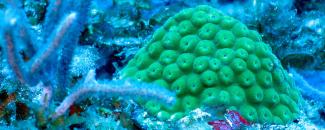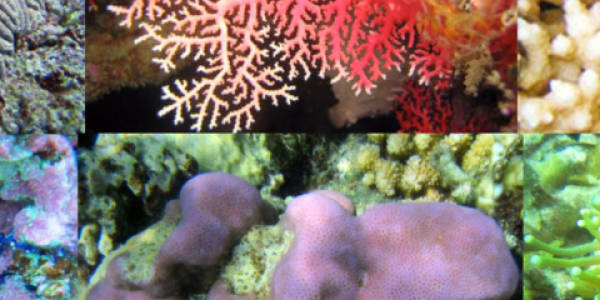
How can scientists learn about climate from these beautiful and essential underwater ecosystems? Many coral reefs have been around for millions of years, yet they are extremely sensitive to changes in climate conditions. Corals are affected by ocean warming (sometimes bleaching when temperatures rise or fall), by pollution and runoff, and by changes in the pH of seawater, which decreases as more carbon dioxide enters the ocean—a trend known as ocean acidification.
Recording Climate with Coral Skeletons
As corals grow, they form skeletons by making calcium carbonate from the ocean waters. The density of these calcium carbonate skeletons changes as the water temperature, light, and nutrient conditions change, giving coral skeletons formed in the summer a different density than those formed in the winter. These seasonal variations in density produce growth rings similar to those in trees. Scientists can study these rings and other characteristics to determine the climate conditions during the seasons in which the coral grew. These growth bands also allow scientists to date coral samples to an exact year and season.
Examining Layers of Data and Information
To gather data and information about coral growth bands, scientists jump in their scuba gear and dive down among the reefs. Once in position, they use a hollow, diamond-tipped drill bit to gather small core samples from the corals without injuring the animal. Sometimes the banding patterns in these samples are evident by visual inspection alone, but often scientists use x-ray imaging software to get a look at the patterns. Then, scientists mark the varying layers by year and season and extract samples from the layers for precise chemical analysis.
Analyzing the composition of trapped oxygen atoms for example, is used to estimate seasonal temperature and rainfall and to build a record of how they have changed through time. Times of environmental stress, including disease outbreaks or bleaching—when a coral animal expels the symbiotic algae that lives within it and gives it its color—can also be identified within the banding. Such markers help paleoclimatologists determine extreme climate conditions that are harmful to the reef.
Investigating the Past to Predict the Future
By using corals to determine the past climate in the tropical oceans, paleoclimatologists can also predict future trends in the climate system. The information corals provide about the tropical oceans can be very useful in examining the El Niño Southern Oscillation. El Niño, which is spawned in the Pacific Ocean, greatly affects weather from Asia and Australia to North and South America. By sampling corals in the Pacific, scientists can determine El Niño patterns over the past few hundred years and use that information to improve predictions about future episodes and changes in this natural climate pattern.
NCEI’s Paleoclimatology Program distributes the data products of various collaborative efforts to collect and organize coral records from around the globe. Check out all of our available coral and sclerosponge pollen data on the Paleoclimatology Program’s Coral and Sclerosponge web page.



